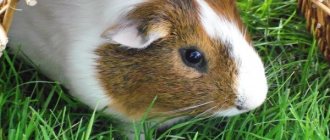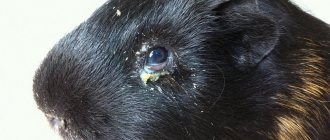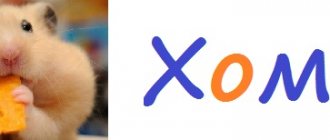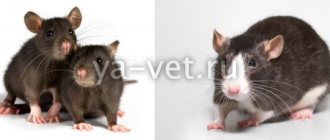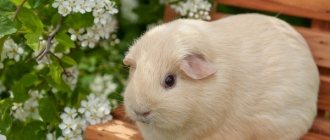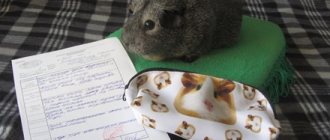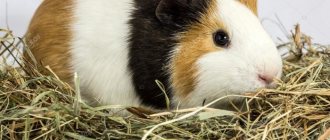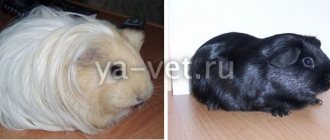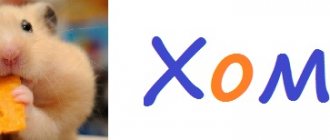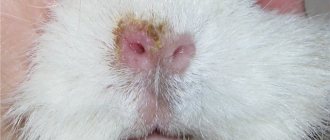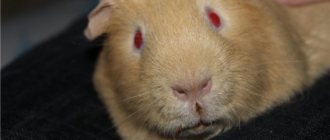- home
- Guinea pig
- Guinea pig health
02/06/2019 Guinea pigs are at risk of developing skin diseases, often not associated with various parasites. This is exactly the disease that lichen is.
What is lichen and why is it dangerous?
“Ringworm” is a common term. In fact, this disease should be called “dermatomycosis”. To be even more precise, this is not one disease, but a whole group of infectious pathologies of fungal origin that affect the skin and coat of animals. Ringworms are considered one of the most dangerous diseases due to their high contagiousness and virulence (in other words, they are highly contagious).
Like any other fungal pathology, lichen greatly suppresses the immune system of a sick pet. There are also many cases where in healthy and young animals some types of lichen can go away on their own (but this happens rarely). Dermatomycosis is dangerous due to its rapid spread in the external environment.
Important! Many varieties are dangerous not only for pigs, but also for other domestic animals, as well as for humans. Because of this, a sick pet must be isolated; it is especially important not to let children and the elderly play with it. Their immunity is too weak, and therefore the likelihood of infection is very high.
In pigs, the disease is most often caused by representatives of two genera of pathogens:
- Microsporum (cause microsporia).
- Trichophyton (pathogens of trichophytosis).
Zhiroviki
A wen most often results from the removal of a lipoma, an abscess, or appears due to infection entering a small wound. If over time the wen does not grow and does not cause any discomfort to the animal, then it does not need to be removed. However, if the wen is painful and significantly increases in size, you should immediately consult a doctor.
The wen can break out on its own and this can lead to not the most pleasant consequences - the formation of tumors under the wen, incomplete release of pus, blood poisoning.
The veterinarian removes not only the wen itself, but also the fat sac. It is this that most often becomes the cause of the recurrence of the wen and the development of tumors. Typically, after surgery, the veterinarian will prescribe a course of antibiotics and complete rest. The wound should be lubricated with ointment and washed with a solution of hydrogen peroxide.
The main types of lichen in guinea pigs
Most often, either microsporia or trichophytosis is detected in animals. Both types of dermatomycosis, by the way, are dangerous for people.
They can be distinguished by the following characteristics:
- Microsporia is characterized by the appearance of ring-shaped bald patches. The skin in these places peels off, in some cases the pet experiences quite severe itching. The development of inflammation is characteristic. The fur over the lesions becomes dull. In addition, with microsporia, the hairs break at a height of approximately 4-6 mm from the skin.
- Trichophytosis is characterized by hair loss. More precisely, they break off flush with the skin, leaving behind a very short “fluff”. Unlike microsporia, there is usually no itching, and the skin is also rarely inflamed. But with trichophytosis, the skin in the affected areas is often covered with multiple pustules.
Diagnostics
To determine whether there is a disease, the following methods are used:
- The affected areas are examined using a UV lamp.
- Wool is taken and examined under a microscope.
- Scraping from diseased areas of the body.
Such methods are used by a veterinarian within the clinic. You can also perform some kind of diagnostics at home. To do this, circle the affected area of the body with a cotton swab. The fungus will have noticeable edges compared to other skin diseases. But this method can only be used when there are no wounds or cracks on the animal’s body.
Although you can independently diagnose the presence of a fungus, you should definitely contact a specialist at a veterinary clinic to prescribe the correct, effective treatment. The doctor will also provide recommendations on the care and prevention of the disease.
Routes of transmission of lichen in guinea pigs
In most cases, infection occurs through direct contact between a sick and healthy animal, but the infection can reach a pet in other ways:
- Each hair inside is “eaten away” by fungi and filled with their spores. Accordingly, upon contact with such fur, the animal has an almost 100% chance of getting sick.
- The spores do not remain in the fallen hairs, but scatter, seeding areas of the environment. They can end up anywhere. Thus, infection can occur through contact of a “pig” with contaminated care items, bedding, hay, etc. The situation is aggravated by the fact that mice are frequent carriers of dermatophyte spores. And they, in turn, often live in the hay... which is fed to the pigs.
What it is
Ringworm is a disease of a viral nature and dermatological nature, the source of which is a fungus that affects the skin. In the absence of measures to prevent its development, it quickly covers the entire body of the rodent. It is contagious and poses a threat to other animals, as well as the owners of a sick pet. Transmitted through direct contact.
The fungus is very tenacious. Its elements and spores remain in the pet’s fur and surrounding area for one and a half years. In this case, the body carrying the disease can remain healthy and not show symptoms of infection. Activation of the disease is facilitated by environmental pollution or weak immunity of a particular individual.
The disease manifests itself at any time of the year, but is more common in the spring-summer and autumn seasons.
Symptoms and signs of lichen in a guinea pig
Regardless of the specific type of pathogen, the first sign of the disease will be the appearance of areas of mycelium growth on the pet’s skin. In most cases, these will be round, hairless areas with rough and thickened skin in the center.
These areas often become scaly as the skin flakes off and falls off. Multiple ulcers often appear in these same places. Itching does not happen in all cases, but if it does, the pig may lose sleep and rest while trying to scratch itself. The first lesions are found near the eyes, ears, and sometimes on the stomach.
Prevention
First of all, you need to protect yourself and your children, since lichen is transmitted to humans. Wear disposable gloves for any contact. The guinea pig is resettled separately and its home is completely disinfected. If possible, boil the bedding and all contents of the cage.
The disease could have started due to a large amount of dust in the room. Don’t forget to do general cleaning and airing of the apartment regularly. This will preserve the health of all residents.
Treatment of lichen in guinea pigs at home
Let us immediately warn you that treatment of lichen in guinea pigs at home is possible only with prior consultation with a veterinarian and subsequent prescription of specific therapy. We will describe basic recommendations for preparing for treatment.
The main condition for successful therapy is good access to the areas of the pet’s skin affected by the fungus. To fulfill this condition, it is necessary to carefully cut the hair near the inflammation.
All fur must be collected and burned. An important element of treatment is bathing with medicated shampoos. After each wash, the sores must be lubricated with ointments.
Skin diseases caused by parasites
Lice and lice eaters
These parasites are especially common in guinea pigs. The first symptoms are severe itching. To detect lice and lice, it is worth examining the skin and fur of the animal under a magnifying glass. If your guinea pig is infested with lice, you will see larvae among the hairs. Nits have a pear-shaped body and measure half a centimeter. Lice eaters are much smaller - the length of an adult insect is about a millimeter. They feed not only on skin scales, but also on the blood of the animal.
It is impossible to comb out insects with a regular brush.
Insecticides are a good way to control parasites. The guinea pig should be placed in a 1% netritonate solution or in a 0.5% bromocyclene solution for several minutes. The procedure should be repeated every seven days for three weeks. Before the procedure, you should also treat the cage with a bromocyclene solution and change all the bedding.
Fungal diseases
Fungus in guinea pigs can often be observed on the face. The first symptoms are hair loss, itching, peeling of the skin. After the muzzle, the fungus affects the paws, ears, chest, and neck. The first type of fungus is dermatophyte. It affects the nails, hair and the stratum corneum of the epidermis of the skin.
Weakened animals, as well as pregnant and lactating females and young individuals are susceptible to infection.
Prevention of the disease includes:
- regular cleaning of the cage and change of bedding (the fungus actively multiplies in a dirty environment),
- high-quality and clean feed,
- low humidity in the room where the animal is kept,
- regular treatment for internal parasites.
If the veterinarian has determined the presence of a fungus - dermatophyte, then the sick animal must be transplanted into a separate cage (it is better to use a terrarium or an aquarium to avoid the spread of spores). The cage where the guinea pig was kept must be thoroughly washed with any chlorine-containing solution. For treatment, you can use Nizoral shampoo, which is sold in pharmacies. It has a good antifungal effect, reduces itching and eliminates skin flaking. Apply the shampoo to the fungus-affected areas of the body for a few minutes, then rinse with warm running water.
Fungoterbin 1% cream, as well as Termikon 1% cream, also help fight fungus well. The cream should be applied to the affected area of the body. Repeat the procedure twice a day until complete recovery.
Lichen
Ringworm in guinea pigs is caused by several types of fungus, the spores of which can be carried not only by people, but also by pets and poor-quality food. A guinea pig can become infected with lichen while walking - very often fungal spores are found in the soil and on the grass. Most often, weakened animals and animals kept in poor conditions are susceptible to the disease. The first symptoms are hair loss. Bare areas of skin are red, dry and with noticeable peeling, covered with a dry crust. Ringworm first affects the muzzle and ears, front and hind legs, and then spreads throughout the body. A sick animal experiences severe itching, loses rest and appetite. Through open scratched wounds, various pathogenic bacteria can enter the bloodstream.
Lichen can only be determined by scraping the skin in the laboratory.
A sick guinea pig should be immediately isolated from other animals. The fur around the affected areas should be shaved. The cage where the pig was kept, as well as all feeders, houses and other items, must be thoroughly washed with any chlorine-containing composition. Guinea pigs are treated for shingles with antifungal drugs (clotrimazole or miconazole), as well as frequent washing with a keratolytic shampoo. The danger of deprivation is that it can be transmitted to people. Children, as well as pregnant women and people with weakened immune systems are most vulnerable. Their contact with the sick animal should be completely excluded.
Pododermatitis
Pododermatitis or corns are a consequence of improper care of animals. Dirty bedding, excessively long nails of an animal, or the use of wood pellets for bedding can lead to the formation of painful tumors on the paws and the appearance of purulent wounds. The cause of corns can be the obesity of the animal, as well as diseases of the internal organs. To determine the exact cause, it is recommended to consult a veterinarian and take a blood test. Pododermatitis can only be cured if treatment is started on time. Typically, in the normal course of the disease, the treatment period takes up to two months.
Treatment of pododermatitis consists of daily treatment of the wounds with chlorhexidine, cleansing the wounds of pus and lubricating the affected areas with Levomekol ointment in the morning and Solcoseryl in the evening. When the wounds have completely healed and the discharge of pus has stopped, it is good to lubricate the skin with zinc ointment. If the disease is in a severe stage, then antibacterial drugs should be used and tissue x-rays should be taken. Pododermatitis can lead to bone deformation.
Pododermatitis requires not only drug treatment, but also a complete change in the animal’s diet, as well as living conditions. It is necessary to carefully monitor the weight of the animal, the length of its claws and teeth.
The guinea pig should be kept in a cage with soft bedding, and if the wounds bleed, use any soft cloth as bedding.
Pharmacy products used
Please note that many pharmaceutical products used may be unsafe for the health of the animal (especially antifungal medications). Therefore, they must be used only with the knowledge and approval of the veterinarian!
Ointments
The following ointments can be used in the treatment of lichen:
- Salicylic. It has a double effect: it is not only an excellent antiseptic, but also a means that accelerates the regeneration process of damaged skin. The duration of treatment is at least 10 days, the drug is applied three times a day. When processing, it is necessary to apply the ointment in broad strokes, covering the inflamed areas and areas of healthy skin around them.
- Sulfuric. This simple and cheap drug has a good antifungal effect. The duration of treatment is at least three weeks, the frequency of application is three times a day. To achieve the best effect, the ointment is best used in the form of applications. To do this, a gauze swab is thickly impregnated with the product and glued with a band-aid to the most noticeable lesions. The bandage is changed at least once every two days.
- Ichthyol. A good auxiliary agent with a pronounced anti-inflammatory effect. The frequency of treatment is twice a day throughout the entire treatment period.
- Ointment Yam. It has a very specific smell and an equally distinctive consistency. Despite the “aroma,” when applied to the fungal lesions up to three times a day for two weeks, it often helps to cure the animal without resorting to the use of more serious (and very toxic) drugs.
Causes
Why does this disease occur? Most often, the fungus appears when:
- weak immunity;
- stress;
- improper diet;
- poor quality care.
The cause of the disease can be either one or several. Fungal spores multiply on dirty litter because it is favorable soil for them. If animals are kept in close quarters, skin fungus can appear in all animals.
The disease manifests itself in the form of thinning hair, bald spots, flaking, dandruff, and white skin plaque. Guinea pigs with fungus suffer from itching and the affected areas itch. This can cause a secondary infection as bacteria enter such areas. In this case, treatment becomes more complicated.
Folk remedies
Some folk remedies cannot be called “original folk”, but official veterinary medicine does not use them. Despite this, some breeders achieve very good results with their help:
- Simple greenery helps a lot. Apply to areas of inflammation once a day. Treatment period is up to one and a half weeks.
- Alcohol tincture of iodine works similarly. It is used in the same way. Remember that excess iodine can cause chemical burns!
- Birch tar. They lubricate the “mushroom” areas no more than twice a day. Treatment period is up to one week.
Summing up
Thus, there are many ways to treat shingles. However, for their comprehensive use, not to mention a qualified diagnosis, you should definitely consult a specialist. Treating your guinea pig on your own can only make the problem worse.
In any case, it is worth remembering about preventive measures. The best way to preserve the mood, time and money, as well as the health of your beloved pet, is to simply prevent him from getting sick.
Source
Pseudotuberculosis
We bring to your attention a description of the most common disease in these domestic rodents. The causative agent of this disease is pathogenic microflora, which enters the body through spoiled or low-quality food.
Main symptoms:
- diarrhea;
- the animal does not eat anything;
- After some time, the rodent becomes skinny, which leads to paralysis.
Such a rodent should be immediately isolated and shown to a veterinarian.
Treatment of the disease is carried out in a hospital setting.
Treatment of pityriasis
When a patient is diagnosed with Gibert's disease, the dermatologist develops an individual treatment regimen to avoid dangerous complications. There is an opinion that pityriasis rosea will go away on its own in a few weeks. As a result, complications arise, and the patient comes to the dermatologist with an advanced form of the disease.
Drug treatment includes the following medications:
- antihistamines that relieve the patient from itching, swelling and redness on the body
- corticosteroid, desensitizing and antipruritic ointments. Medicinal compositions containing betamethasone, hydrocortisone, etc. are applied to the affected skin and lightly rubbed in. The medications eliminate rashes, get rid of peeling, and effectively restore the skin.
- drying agents containing zinc to accelerate skin healing
- Broad-spectrum antibiotics are indicated in cases where a bacterial infection is associated with pityriasis rosea. It is unacceptable to start taking antibacterial drugs on your own, since they are selected individually, taking into account laboratory tests.
- antifungal medications: drugs containing clotrimazole and other active substances are prescribed topically in the form of gels and ointments
- antiviral drugs containing acyclovir and other active components. Dermatological tests have confirmed that if antiviral drugs are prescribed in combination with antibiotics from the first days, the patient quickly recovers.
- neutral water-shaken preparations Dermatologists prescribe pharmacy talkers containing zinc oxide, menthol and anesthesin to patients with pityriasis rosea. These products relieve itching and pain in damaged areas and speed up recovery.
- iodine is an aggressive, but extremely effective remedy. Injured skin is treated with iodine in the morning and evening. Initially, the skin begins to peel off more actively, but then there are no extra scales left on it. Not all experts recommend that their patients cauterize damaged areas with iodine, since this drug can be harmful if used incorrectly.
Recommendations for patients
During the treatment period, the patient is recommended to adhere to the following recommendations:
- Follow a hypoallergenic diet: avoid nuts, citrus fruits, chocolates, honey, etc. Products containing artificial colors should be excluded from the menu. It is worth limiting the consumption of fried foods, carbonated drinks, fast food, strong alcohol and coffee.
- Limit water treatments within reasonable limits and give preference to the shower.
- Refuse to use aggressive hygiene and cosmetic products for the body. Gels and other detergents should not dry out the skin.
- Give preference to underwear made from natural fabrics.
- Moderate sunbathing - ultraviolet light helps the skin recover faster.
- Follow the recommendations of a dermatologist, apply to the skin only products recommended by a specialist.
- Folk remedies can be used only after consultation with your doctor.
Rickets
The development of this disease is caused by a lack of vitamins or minerals in the rodent's body. At each stage of this disease, different symptoms appear. First, the animal experiences gastrointestinal upset, then a desire to eat inedible foods and objects appears - bedding, calla lilies, soil, lime.
Externally, this disease can manifest itself as follows:
- hunched over;
- paws are bent;
- joints thicken;
Guinea pigs suffering from rickets are noticeably retarded in growth and development.
The greatest likelihood of developing rickets is observed at a young age, with a monotonous diet. The most favorable season is winter. Since it is during this period that the required amount of fruits and vegetables required by the young body is missing.
Animals suffering from rickets are placed separately from healthy animals. During the treatment period they are given trivitamin or trivit. Irradiation procedures are carried out with a quartz lamp (10 sessions of 10 minutes each). Fish oil (vitamin D and A concentrate) is added to dry food.
Eye diseases
Inspect the appearance of the pig
Guinea pigs have different eye diseases. Some of them are very dangerous and can lead to complete loss of vision. Let's look at each of them in detail.
Watery eyes
This reaction of the body in guinea pigs is not uncommon. Because it can be caused by an allergic reaction to a new food product, bedding. Eyes also become watery due to poor care, when the animal’s home is not cleaned in a timely manner. Therefore, in order to prevent such manifestations, it is necessary to review the food menu and the conditions for keeping the animal.
To alleviate the animal’s condition, wash the animal’s eyes with chamomile decoction and instill eye drops - Iris and Levomycetin.
Conjunctivitis
This disease is caused by inflammation of the mucous membrane of the eye. The main reason is eye injury. With unilateral conjunctivitis, one eye is inflamed, with bilateral conjunctivitis, both eyes are inflamed. With such diseases, guinea pigs exhibit the following symptoms:
- tearing, swelling of the eyes;
- sticking and redness of the eyelids;
- at an advanced stage there may be purulent discharge from the eyes.
If timely measures are not taken, the animal’s cornea becomes affected and becomes cloudy, and over time, vision completely disappears.
Treatment occurs in several stages. First, remove the dried pus around the eyes by soaking it with albucid (3% solution). After the eye opens slightly, the affected area is lubricated with tetracycline or hydrocartisone ointment using a cotton swab. The area around the eyes is also treated with one of these drugs.
At an advanced stage, when the cornea has become cloudy, a mixture of powdered sugar and calomel is blown into the eyes.
Secretions of the Harderian glands
Your piggy has a constant white discharge from his eyes - there may be some kind of infection. Milky leucorrhoea of the Harderian glands can be caused by pathogenic microflora - bacteria, fungus. Only a veterinarian can determine the pathogen.
A bacterial culture is carried out to check for their presence. Treatment is determined according to the cause of the disease.
Belmo
Cataracts (cataracts) are common in guinea pigs. First, the crystal becomes cloudy, then vision is impaired until it is completely lost. This can be either a congenital or acquired disease. In older animals, cataract is considered a senile pathology. You may notice how the affected eye is enlarged compared to the healthy eye. Cataracts develop for several reasons;
- injury to the eyeball;
- diabetes;
- chronic inflammatory processes.
The affected areas are instilled with eye drops - Tobrex, Tsiprovet, Balarpan. After the drops, Solcoseryl regenerating ointment is applied to the eyes.
Pasteurellosis
You can understand that a guinea pig has fallen ill with pasteurellosis by several signs:
- mucus around nostrils;
- runny nose;
- the animal sneezes often.
As a result of such sensations, the pig develops severe irritation in the affected area. The rodent constantly scratches its nose with its paws, and thus aggravates the course of the disease. First, mucous and then purulent white or grayish discharge flows from the nose. Breathing becomes difficult. You can hear the animal snoring or snoring. At an advanced stage, purulent wounds appear on the skin.
The causative agent of this disease is pathogenic microbes. At the initial stage, it is quite easy to destroy the pathogen. For these purposes, the animal is given disinfectants.
If the causative agent of pasteurellosis enters the blood through wounds, the blood system becomes infected. Infection is accompanied by fever, weakness, diarrhea, and in rare cases, convulsions. It is almost impossible to cure an animal whose blood is infected with the causative agent of pasteurellosis. Therefore, it is simply destroyed.
For animals that are suspected of being infected with this infection, the veterinarian prescribes sulfa drugs and antibiotics.
